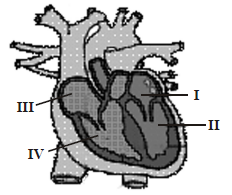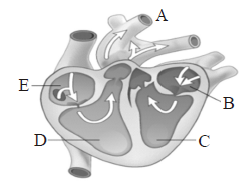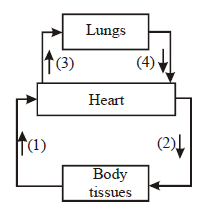Please see Chapter 18 Body Fluids and Circulation Exam Questions Class 11 Biology below. These important questions with solutions have been prepared based on the latest examination guidelines and syllabus issued by CBSE, NCERT, and KVS. We have provided Class 11 Biology Exam Questions and answers for all chapters in your NCERT Book for Class 11 Biology. These solved problems for Biological Classification in Class 11 Biology will help you to score more marks in upcoming examinations.
Exam Questions Chapter 18 Body Fluids and Circulation Class 11 Biology
Objective Question
Question. Which of the following blood groups is universal donor and acceptor respectively?
(a) AB, O
(b) O, AB
(c) AB, A
(d) A, AB
Answer
B
Question. Rh factor is responsible for
(a) Sickle cell anaemia
(b) Erythroblastosis foetalis
(c) AIDS
(d) Turner syndrome
Answer
B
Question. In erythropblastosis foetalis, which of the following factors passes through placenta into foetus
(a) Rh antigens
(b) Rh antibodies
(c) Agglutinins
(d) ABO antibodies
Answer
B
Question. T-wave represents
(a) Depolarisation of ventricles
(b) Repolarisation of ventricle
(c) Repolarisation of atria
(d) Depolarisation of atria
Answer
B
Question. Which of the following is expected if husband is Rh+ and wife is Rh-?
(a) No problem with 1st pregnancy
(b) Problem would be expected in future pregnancy
(c) Both
(d) No problem in any pregnancy
Answer
C
Question. What is the correct order of events?
A. Conversion of fibrinogen to fibrin
B. Clot retraction and leakage of serum
C. Thromboplastin formation
D. Conversion of Prothrombin to thrombin
Options :
(a) C, B, A, D
(b) C, D, A, B
(c) C, D, B, A
(d) D, A, C, B
Answer
B
Question. Which of the following statement is wrong about lymph.
A. Lymph is colourful as it has haemoglobin but no RBC
B. The fluid present in lymphatic system is called lymph
C. It contains specialised lymphocytes which are responsible for immunity of the body
D. Lymph is an important carrier for nutrients and hormones
E. Fats are absorbed through lacteals present in the intestinal villi
Options :
(a) Only A
(b) C and D
(c) B and C
(d) Only D
Answer
A
Question. Open Circulatory system is found in
(a) Arthropods and mollusc
(b) Annelids and chordates
(c) Annelids and arthropods
(d) Fishes and molluscs
Answer
A
Question. In an open circulatory system
(a) There is no heart
(b) There is no need of blood vessel
(c) There is no distinction between blood and tissue fluid
(d) There are no open spaces for sinuses in the blood
Answer
C
Question. QRS complex represents
(a) Deplorisation of ventricles
(b) Repolarisation of ventricles
(c) Repolarisation of atria
(d) Depolarisation of atria
Answer
A
Question. Contraction of the ventricle in the heart begins by the command from
(a) Purkinje fibres
(b) AV node
(c) chordae tendinae
(d) SA node
Answer
D
Question. Bicuspid valve allows blood from
(a) right auricle to left ventricle.
(b) right auricle to right ventricle.
(c) left auricle to left ventricle.
(d) post caval to heart.
Answer
C
Question. ‘Bundle of His’ is a part of which one of the following organs in humans?
(a) Brain
(b) Heart
(c) Kidney
(d) Pancreas
Answer
B
Question. A four-chambered heart is found in
(a) mammals only
(b) humans only
(c) all vertebrates
(d) some reptiles, all birds and mammals
Answer
D
Question. Which term does not apply to human heart?
(a) Pacemaker
(b) Four chambered
(c) Mitral valve
(d) Neurogenic
Answer
D
Question. A blockage in aortic valve would directly reduce blood flow to the _______.
(a) heart
(b) liver
(c) lungs
(d) brain
Answer
C
Question. The heart sound ‘dupp’ is produced when
(a) tricuspid valve is opened.
(b) mitral valve is opened.
(c) mitral valve is closed.
(d) semi-lunar valves at the base of aorta get closed.
Answer
D
Question. Closure of which of the following valves makes louder sound of heart beat?
(a) Mitral valve
(b) Seminular valve
(c) Auriculo-ventricular valve
(d) Tricuspid valve
Answer
C
Question. The pattern of contraction and relaxation of the heart is referred to as
(a) blood pressure
(b) arterial flow
(c) blood flow
(d) cardiac cycle
Answer
D
Question. QRS is related to
(a) ventricular contraction
(b) auricular contraction
(c) cardiac cycle
(d) auricular relaxation
Answer
A
Question. Pulmonary artery arises from
(a) right atrium
(b) left atrium
(c) right ventricle
(d) left ventricle
Answer
C
Question. Which structures are directly involved in the pulmonary circulation?
(a) Right atrium, aorta and left ventricle.
(b) Left ventricle, aorta and inferior vena cava.
(c) Superior vena cava, right atrium and left ventricle.
(d) Right ventricle, pulmonary arteries and left atrium.
Answer
D
Question. Which of the following carries oxygenated blood?
(a) Renal vein
(b) Hepatic portal vein
(c) Hepatic vein
(d) Pulmonary vein
Answer
D
Question. In adult man, normal BP is
(a) 100/80 mm Hg
(b) 120/80 mm Hg
(c) 100/120 mm Hg
(d) 80/120 mm Hg
Answer
B
Question. Coronary artery disease (CAD) is often referred to as
(a) heart failure
(b) cardiac arrest
(c) atherosclerosis
(d) angina
Answer
C
Question. In arteriosclerosis
(a) arterial walls become very thin and weak so that the blood oozes out of the walls.
(b) sex linked heredity is involved.
(c) blood coagulates even in the arteries.
(d) arterial walls become inelastic and thickened.
Answer
D
Statement Type Questions
Question. Which of the following statements is correct regarding joint diastole?
(a) Both atria relax but ventricles contract.
(b) Both ventricles relax but atria contract.
(c) Both semilunar valves are open.
(d) Tricuspid and bicuspid valves are open.
Answer
D
Question. Which one of the statement is correct with reference to the circulation of blood in a mammal?
(a) Left auricle receives oxygenated blood.
(b) Pulmonary artery carries oxygenated blood to the lungs.
(c) Blood from the lungs is returned to heart through 2-veins, one from each lung.
(d) None of the above.
Answer
A
Question. Which of the following statement best defines artery?
(a) It carries blood from one visceral organ to another visceral organ.
(b) It carries oxygenated blood to the different organs.
(c) It carries blood away from the heart to different organs.
(d) It breaks up into capillaries which reunite to form a vein.
Answer
C
Assertion/Reason Type Questions
In the following questions, a statement of Assertion is followed by a statement of Reason.
(a) If both Assertion and Reason are true and the Reason is the correct explanation of the Assertion.
(b) If both Assertion and Reason are true but the Reason is not the correct explanation of the Assertion.
(c) If Assertion is true but Reason is false.
(d) If both Assertion and Reason are false.
Question. Assertion : SAN is called the pacemaker of heart.
Reason : The SAN can generate the maximum number of action potentials and is responsible for initiating and maintaining the rhythmic contractile activity of the heart.
Answer
A
Question. Assertion : Saline water is not given to patients with hypertension.
Reason: Saline water can cause vomiting and may drop blood pressure suddenly causing cardiac arrest.
Answer
C
Question. Assertion: WBCs accumulate at the site of wounds by diapedesis.
Reason: It is squeezing of leucocytes from endothelium.
Answer
B
Question. Assertion : Prothrombinase enzyme acts as antiheparin.
Reason : Heparin prevents coagulation of blood in blood vessels.
Answer
B
Diagram Type Questions
Question. The given diagram represents human heart with four chambers labelled as I, II, III & IV?

Which labelled structure receives carbon dioxide rich blood from the body?
(a) I- Left atrium
(b) II- Left ventricle
(c) III- Right atrium
(d) IV- Right ventricle
Answer
C
Question. In the human heart, blood from the lungs enters the heart through the left atrium, pumps into the left ventricle, out the aorta and through the body, and then returns into the right atrium, pumps into the right ventricle and exits to the lungs.

Using the diagram, which set of letters (A, B, C, D, E) correctly represents the process describe above?
(a) E, D, A, B, C
(b) B, C, A, E, D
(c) C, D, A, B, E
(d) D, C, A, E, B
Answer
B
Question. The given figure represents the pathway of blood throughout the body.

Identify the correct match of marked number 1, 2, 3 and 4.
(a) 1- Artery
(b) 2- Pulmonary vein
(c) 3- Pulmonary artery
(d) 4- Vein
Answer
C
Critical Thinking Type Questions
Question. Which is the correct route through which pulse making impulse travels in the heart?
(a) SA node→ AV node → Bundle of His → Purkinje fibres
(b) AV node → Bundle of His → SA node → Purkinje fibres → heart muscles
(c) AV node → SA node → Purkinje fibres → Bundle of His → heart muscles
(d) SA node → Purkinje fibres → Bundle of His → AV node → heart muscles
Answer
A
Question. Which one of the following will be the cardiac output (in litres per minute) of a heart that has a stroke volume of 0.07 litres and is beating at a rate of 90 per minute?
(a) 63.30
(b) 63.00
(c) 00. 63
(d) 06.30
Answer
C
Question. First heart sound (LUBB) coincides with which wave of ECG?
(a) R-wave
(b) T-wave
(c) P-wave
(d) Q-wave
Answer
A
Question. Maximum amount of oxygen is lost from the blood in the
(a) capillaries surrounding the tissue cells.
(b) arteries of the body.
(c) capillaries surrounding the alveoli.
(d) left auricle of the heart.
Answer
A
Question. If due to some injury, the chordae tendinae of the tricuspid valve of the human heart is partially non-functional, what will be the immediate effect?
(a) The flow of blood into the pulmonary artery will be reduced.
(b) The flow of blood into the aorta will be slowed down.
(c) The ‘pacemaker’ will stop working.
(d) The blood will tend to flow back into the left atrium.
Answer
A